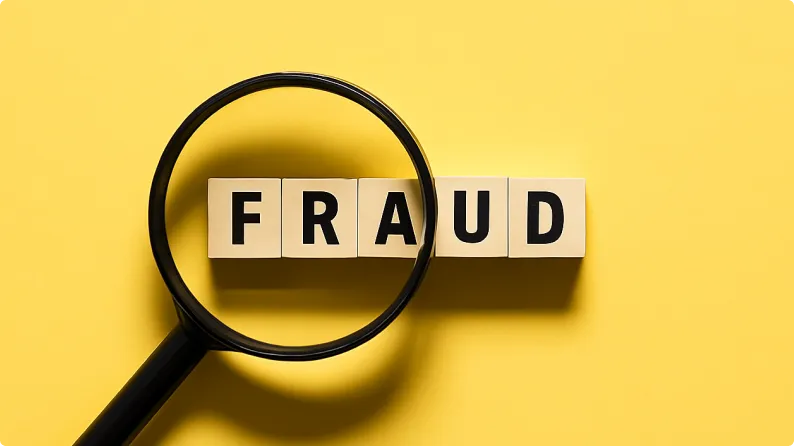On this page
Loyalty programs lose an estimated $1 billion to $3 billion annually due to fraud.
Once seen as a simple marketing tool, loyalty programs have transformed into modern solutions for customer retention, rich with data and digital currency-like points. Today, they’re embedded across industries from airlines and hotels to retail and healthcare, and are responsible for driving billions in repeat business.
But with that value comes vulnerability. Fraudsters are increasingly targeting these programs using methods like bot attacks, fake accounts, and insider abuse. And unlike credit card fraud, loyalty fraud often goes undetected, remaining unnoticed until the damage is done.
This blog unpacks the world of loyalty program fraud. We’ll explore what it looks like, share real-world scam examples, and offer practical strategies to detect and prevent it, so your brand continues to reward the right people.
What Is loyalty program fraud?
Loyalty program fraud is the unauthorized use, manipulation, or abuse of a rewards or loyalty program by individuals or entities intending to gain unearned benefits.
Loyalty fraud typically involves stealing or falsifying loyalty points through tactics such as account takeovers, fake sign-ups, or system exploitation.
As loyalty programs evolve into high-value digital assets, they’ve become prime targets for increasingly sophisticated fraud schemes. Over 72% of loyalty programs have experienced some form of fraud.

In essence, loyalty points have become a form of digital currency that can be redeemed for goods, services, or discounts, or even sold on black markets, making them extremely attractive to fraudsters.
Mastercard’s insights on loyalty fraud highlight that loyalty programs are often not protected with the same rigor as payment systems, despite the comparable financial value involved.
The evolving nature of the tactics used makes loyalty fraud detection especially challenging. Fraudsters employ various methods, including credential stuffing, phishing, automated bot attacks, and insider collusion. Businesses must be prepared to combat fraud that is more common, sophisticated, and scalable than ever.
As rewards programs continue to grow in popularity across various industries, the need for robust loyalty program fraud prevention strategies is more urgent than ever.
Common types of loyalty fraud
Loyalty programs are designed to reward genuine customer engagement; however, when fraudsters exploit program loopholes, businesses suffer financial losses, damaged trust, and weakened loyalty.
Loyalty program fraud now accounts for 31% of all fraud attempts against online merchants, making it one of the most significant threats in digital commerce.
Let’s understand some of the most common types of loyalty fraud:
1. Account takeovers exploit stolen credentials to drain user points
Account takeovers occur when fraudsters access a legitimate customer’s loyalty account.
This is often accomplished through:
- Phishing attacks that trick users into sharing login credentials.
- Credential stuffing, where leaked passwords from other platforms are used to gain access to loyalty accounts.
Once inside, the fraudster will steal all your accumulated points, change account details, or transfer rewards without the rightful owner realizing it until it’s too late. This attack results in direct financial loss and erodes customer trust in the brand.
2. Fake account creation leads to the misuse of referral rewards
Fraudsters exploit sign-up bonuses, referral rewards, and onboarding incentives by creating fake or duplicate accounts to obtain these benefits. Using fictitious email addresses, virtual phone numbers, or synthetic identities, they game the system to accumulate unearned rewards.
Fraud rings sometimes automate this process at scale, especially in industries with low verification thresholds. Without proper fraud detection tools, businesses may pay thousands in illegitimate rewards, skewing engagement data, and draining marketing budgets on referral campaigns that don’t result in “real” membership growth.
3. Insider or employee fraud leads to the illegitimate use of reward points
Not all threats come from outside. Employees with access to the loyalty system may create phantom accounts and funnel points.
Employees with bad intentions will manually adjust point balances without authorization or issue unearned rewards to friends, family, or themselves.
Because insiders often know how to bypass controls or evade detection, this type of fraud can be more challenging to trace and potentially more damaging in the long run.
4. Bot attacks overwhelm systems and skew campaign metrics
Bots are increasingly used to automate fraudulent activities in loyalty programs, such as:
- Creating multiple fake accounts within seconds
- Logging into thousands of accounts using stolen credentials
- Scraping reward opportunities from websites and mobile apps
- Stealing points from inactive accounts
Bot attacks are hazardous because of their speed and scale. They overwhelm systems, skew campaign metrics, and deplete rewards inventory before genuine users even get a chance to participate.
5. Returns abuse exploits redemption before refund
Also known as “buy and fly” or “earn and return”, this tactic involves customers purchasing an item to earn loyalty points, redeeming the points immediately, and returning the item for a full refund, while keeping the rewards.
In retail and e-commerce industries, this abuse is particularly challenging to detect unless loyalty and return systems are fully integrated.
6. Reselling loyalty points turns your program into black market currency
Once loyalty points are earned legitimately or fraudulently, they may be resold on black-market or peer-to-peer forums. This illicit economy turns your reward system into a currency exchange, undermining your brand value and financial controls.
Fraudsters often target high-value programs (airlines, hotels, or credit card rewards) where points have clear monetary value. However, any loyalty program offering transferable or redeemable rewards is potentially at risk.
7. Coupon abuse drains program value through illegitimate redemptions
Fraudsters exploit promo codes, coupons, or discount offers by using the same code multiple times across fake accounts. Scammers share single-use coupons on public forums, combining multiple discounts against program terms.
This reduces profit margins and distorts the effectiveness of promotional campaigns. Without proper redemption controls, brands lose thousands of unintended discounts and devalue loyalty offerings.
8. Identity theft to access or create accounts
Fraudsters may steal personally identifiable information (PII) such as names, phone numbers, or email addresses from data breaches.
This is done to take over existing loyalty accounts, create new accounts that appear legitimate, and redeem rewards under stolen identities.
This fraud combines digital impersonation with unauthorized access, making detection difficult and causing long-lasting damage.
9. Trick customers into sharing data for a fake loyalty program
Fraudsters create fraudulent loyalty programs or clone existing brand websites to deceive customers into signing up with personal and financial information.
They add phishing links disguised as “rewards,” which lead to malware downloading through fake promotional offers.
These scams also tarnish the reputation of legitimate brands. Victims may blame the real company for the breach, even if it had no involvement.
10. Program manipulation exploits system loopholes and technical glitches
Tech-savvy users deliberately test the limits of loyalty platforms to exploit calculation bugs or timing glitches.
Fraudsters earn extra points by repeating actions that are not properly rate-limited and redeeming rewards through unapproved workflows or outdated links.
Industries impact and real-world loyalty scam examples
While loyalty programs are intended to foster brand love and customer retention, they’ve become high-value targets for cybercriminals and fraudsters. Real-world cases across industries reveal how pervasive and costly these scams can be.
Here are some examples of loyalty scams across industries:
1. Airline loyalty program breaches
Airlines operate some of the world’s most lucrative loyalty programs, making them frequent targets for account takeovers.
In 2015, British Airways suffered a major breach where hackers accessed tens of thousands of Executive Club accounts and drained air miles. Similarly, in 2021, Lufthansa’s Miles & More program was targeted by fraudsters who exploited weak password security and phishing scams.
These breaches caused financial losses through unauthorized redemptions and forced airlines to invest millions in customer outreach, account resets, and fraud prevention infrastructure.
Takeaway: Loyalty points have become a new form of digital currency, just as attractive to hackers as credit card numbers.
2. Australian Loyalty Points Phishing Scam
In 2023, the loyalty programs of Australian companies Qantas Frequent Flyer, Telstra, and Coles reported over 200 scams to the Australian Competition and Consumer Commission (ACCC) via its Scamwatch in just four months.
The phishing attack was through:
- Fake SMS/ emails claiming points are about to expire
- Links to convincing replica websites
- Harvested login credentials
- Used stolen data for identity fraud on other platforms.
3. Retail bot attacks
Retailers running point-based programs often see massive spikes in fraudulent activity during sales and promotions.
Automated bot attacks can drain the entire inventory of loyalty rewards within hours, long before legitimate shoppers have a chance to redeem their points.
Takeaway: Without bot protection and activity monitoring, retailers risk alienating loyal customers and losing control of their reward ecosystems.
4. Hotel loyalty breach
Marriott International disclosed a massive data breach affecting up to 500 million guests.
The breach involved unauthorized access to the Starwood guest reservation database, compromising sensitive information, including passport details, payment card numbers, and loyalty program data.
The hotel loyalty program breach damaged Marriott’s reputation and led to regulatory scrutiny, lawsuits, and significant investments in data security overhauls.
Takeaway: Loyalty programs are rich data mines. They expose points and identities when breached, risking customer trust and corporate credibility.
5. Healthcare and pharmacy loyalty abuse
Healthcare and pharmacy-based loyalty programs, particularly those offering medication discounts or wellness rewards, are also susceptible to fraud.
Fraud in the industry can take various forms. A California pharmacist orchestrated a scheme where he created fictitious patient profiles within the pharmacy's digital system. He then added fraudulent prescriptions to these fake profiles and submitted false claims to Medicare for medications that were never dispensed.
This fraudulent activity resulted in Medicare paying approximately $600,000 and over $1 million.
Takeaway: In regulated industries like healthcare, loyalty fraud leads to financial loss and carries compliance and legal risks.
The impact of loyalty fraud on businesses
Loyalty program fraud has become a growing threat that impacts profitability, customer trust, and operational efficiency across various industries.
Below is a breakdown of the key consequences that businesses face due to loyalty fraud:
1. Financial losses
One of the most immediate and visible impacts of loyalty fraud is the financial loss it causes. Rewards fraud has increased dramatically, with estimates ranging from $1 billion to $3 billion in annual global fraud losses.
Fraudulent redemptions, account manipulations, and misuse of referral bonuses drain program value. Over time, these losses accumulate, eroding marketing return on investment (ROI) and program profitability.
Companies also incur additional costs, including investigating fraud, reimbursing affected customers, and implementing stronger fraud detection tools.
2. Erosion of customer trust and engagement
A study revealed that 64% of global consumers report that fraud incidents negatively impact their perception of the brand responsible for the breach.
Customers who fall victim to loyalty fraud through stolen points or compromised accounts often lose trust in the brand. Customers who aren't directly affected may question the program's security.
This leads to decreased engagement, lower redemption rates, and ultimately, a decline in program participation.

3. Reputation damage and legal risks
Loyalty program fraud often makes headlines, especially when high-profile breaches or internal misconduct are involved. Negative press, regulatory scrutiny, and legal action can follow, especially in cases where personal data is compromised.
The reputational damage can linger, affecting customer acquisition and retention well beyond the immediate aftermath.
4. Operational disruptions
Fraud leads to operational disruptions, as businesses must handle increased support requests and customer disputes and manually review fraudulent activities.
These disruptions divert valuable resources from core operations, affecting overall service quality and further eroding customer satisfaction.
5. Sector-specific risks
Specific B2C sectors are particularly vulnerable to loyalty fraud:
- Retail: Retailers face challenges such as creating fake accounts and abusing promo codes, resulting in financial losses and declining customer trust.
- Healthcare: Pharmacy-based loyalty programs have been exploited by creating fake patient profiles to earn bonus incentives tied to prescription referrals.
- Hospitality: Hotels and airlines are targeted for their valuable reward points, which can be redeemed for free stays or flights.
As AI becomes increasingly accessible, the risk intensifies across industries. Giving fraudsters the ability to generate entire networks of realistic-looking fake profiles at scale and speed.
Loyalty program fraud prevention strategies
Preventing loyalty program fraud requires a proactive, layered defense approach. Fraud tactics are evolving rapidly, so brands must secure every phase of the loyalty journey from sign-up to redemption.
Below are some effective prevention strategies organized by stage:
1. At sign-up: Block bad actors at the gate
The first line of defense in loyalty program fraud prevention is ensuring that only legitimate users are able to join. Fraudsters often create fake or synthetic accounts to exploit sign-up bonuses or referral rewards.
Some solutions that can help here are:
- CAPTCHA implementation: Helps detect and block automated bot sign-ups.
- Identity verification tools: Require phone or email verification, or use identity-proofing software to confirm that accounts are associated with real individuals.
- IP reputation checks: Identify and restrict access from high-risk geographies or IP addresses commonly associated with fraud rings.
2. During ongoing use: Monitor behavior and detect anomalies
Once users are active, continuous monitoring is essential to detect suspicious patterns before sensitive information is stolen or misused. Enabling multi-factor authentication (MFA) adds a strong security layer during login or redemption, making it more difficult for fraudsters to access stolen accounts.
Enabling geofencing and device fingerprinting helps flag access attempts from unusual locations or new devices not previously associated with the account.
Additionally, when developing a loyalty program, consistently analyze usage patterns, such as redemption frequency, login times, or referral behavior, to identify unusual activity that may indicate fraud.
3. Internal controls: Secure from the inside
Some of the most damaging loyalty fraud cases occur within the organization.
Conduct regular employee audits to assess loyalty program systems and customer data.
Additionally, ensure that employees only access data and perform actions relevant to their job function, minimizing the risk of misuse.
Companies should maintain detailed logs of all employee interactions with loyalty systems and establish real-time alerts for suspicious behavior.
4. AI and machine learning: Detect complex fraud tactics
Modern fraudsters use sophisticated, adaptive techniques. An AI-powered loyalty management solution will help seek real-time detection and adaptive responses.
Opt for a loyalty management solution that helps anticipate and flag fraud attempts based on patterns, timing, and historical data. Track deviations from normal user behavior across large datasets that would be difficult for human teams to detect.
5. Partnerships with fraud prevention vendors: Strengthen your defenses
Outsourcing fraud prevention capabilities will help you stay ahead of new threats without building everything in-house.
To strengthen your loyalty program, ensure you onboard a loyalty management solution, such as Loyalife. This solution will help with identity verification, bot detection, and risk scoring directly into your loyalty platform.
Partner with cybersecurity or loyalty fraud detection vendors specializing in real-time monitoring and response.
6. Educate customers: Build a first line of defense
Convert your customers from weakest link to your strongest link.
While sign-up encourage customer to have a strong and unique passwords. Send alerts or tutorials about how to spot and report suspicious emails or login attempts. Give your users tips to recognize unauthorized redemptions or account changes.
7. Limit Redemptions: To avoid misuse and track risky behavior
Capping redemptions or adjusting rules limit the damage fraudsters do. While developing your loyalty program set maximum redemption values to prevent large-scale point cashouts.
Limit how often a user can redeem or refer and make high-value redemptions available only to verified or long-term users.
Work with a fraud-aware loyalty management solution like Loyalife to enforce these limits.
8. Conduct regular audits: Stay ahead of emerging loopholes
Your loyalty program should also evolve as the type of loyalty fraud evolves. Conduct routine examination of user activity logs, referral patterns, and redemption histories.
Identify and patch loopholes that can be exploited (e.g., double-dipping, stacking coupons).
How loyalife helps prevent loyalty program fraud
Loyalife offers a robust, AI-powered loyalty management platform to safeguard any loyalty program (from hotels and spas to real estate) against fraud while enhancing customer engagement.
Here's how Loyalife will contribute to your loyalty program fraud prevention:
1. Secure reward management
Loyalife's configurable rule engine allows businesses to define precise earning and redemption rules, ensuring that rewards are granted only for legitimate activities.
Implementing a maker-checker process, Loyalife ensures that critical changes undergo multiple levels of review and approval, thereby reducing the risk of unauthorized modifications.
2. Real-time monitoring
Loyalife provides real-time monitoring of all loyalty-related transactions, including point accruals and redemptions, enabling immediate detection of suspicious activities.
The platform's AI-driven anomaly detection identifies irregular patterns in user behavior, such as sudden spikes in point redemptions, signaling potential fraud.
3. Partner verification and safe referral handling
Loyalife's partner management tools ensure that only verified partners participate in the loyalty program, mitigating risks associated with fraudulent partner activities.
The platform supports secure referral tracking, ensuring referral bonuses are only awarded for genuine, verified referrals.
4. Insights dashboard for fraud detection
Loyalife offers intuitive dashboards that provide actionable insights into customer behavior and program performance, aiding in the early detection of fraudulent activities.
Detailed reports on member activities and transaction histories enable businesses to conduct thorough audits and identify potential fraud patterns.
These features help Loyalife empower businesses to proactively detect and prevent loyalty program fraud, ensuring the integrity of their programs and maintaining customer trust.
With its intelligent monitoring system, which flags point accruals and redemptions in real time, Loyalife ensures that even minor signs of fraud don’t slip through the cracks.
Conclusion
Loyalty program fraud is a growing, sophisticated threat that can erode customer trust, devalue programs, and damage your brand’s reputation. As fraud tactics evolve, so must the strategies used to combat them.
Being proactive is no longer optional. Businesses must continually monitor behavior, strengthen internal controls, and utilize data-driven insights to stay ahead of malicious actors.
By onboarding an effective loyalty management solution, you protect your program against fraud and create a more secure, transparent, and rewarding customer experience. Discover Loyalife, providing end-to-end loyalty infrastructure for enterprises to drive customer engagement and growth.
Book your demo with Loyalife today to safeguard your loyalty program and build lasting customer trust.















